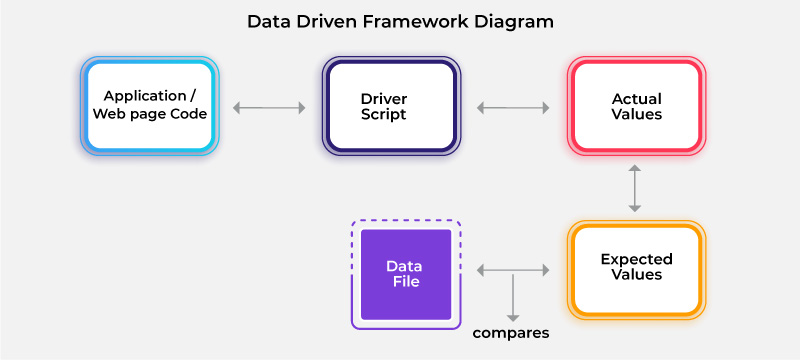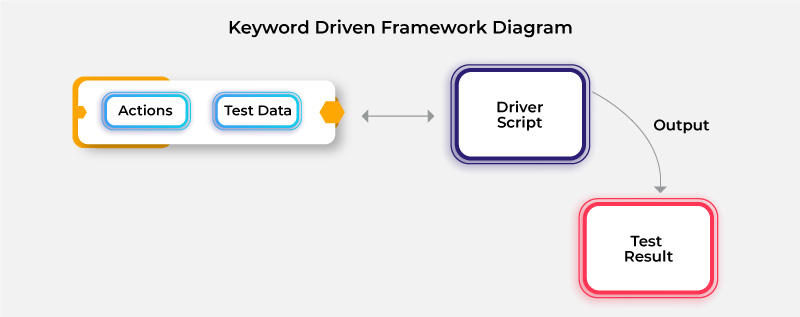All you need to know about the different Testing Frameworks –
Creating the framework is a very important aspect of Automation as the framework is the skeleton to build the reusable scripts.
A framework is a set of methods or best standards of script development that have been constructed in a structured way to accomplish the desired results.
Before starting to create the automation scripts and developing the cases, it is important that we chose the right framework for our project
In different organizations, different frameworks are created as per the requirement and the project.
The different types of Frameworks –
1) Data Driven Framework
2) Keyword driven Framework
3) Hybrid Framework
Data Driven Framework

– This framework is guided by passing the data in the script in form of parameters
– Test case logic resides inside test scripts and test data is kept outside test scripts.
– This type of framework is also called Parameterization.
Where is Data Driven Framework used?
Generally Data Driven framework is used in applications where the data is known beforehand and the testing is purely based on validating the input and checking if desired output is obtained.
It is generally used in CRM applications where data is stored in excel or csv files and data is read directly from the excel files to check whether a valid or inavlid result is obtained.
Benefits of a Data Driven Framework –
1. Increased Stability – with the same test cases, both positive and negative scenarios can be tested easily by just passing the test data in the form of parameters.
2. Decreased number of Test scripts – Total count of test scripts is reduced greatly as the same test scripts can be executed multiple times with different data sets
3. Less Room for Errors – As test data and test scripts are independent of each other, each of these can be updated independently without causing an interference.
Drawbacks of Data Driven Framework –
1. This kind of framework cannot be implemented for more complex applications where the UX/UI, is needed to be tested and limits the scope of test coverage
2. If the data file’s quality is compromised , then the scripts won’t be able to process the file and errors will occur during execution.
3. For every test case, it is inconvenient to keep a separate data file for each of the pages. Every page has a different data set and it becomes hard to keep track of the data set.
Keyword Driven Framework

Keyword driven framework
In Keyword-driven testing, usually a spreadsheet, is primarily implemented to assign keywords for each functionality or test case the tester executes.
In this type of framework, the application’s functionality is detailed and carried out step by step by referencing the table where all steps are noted down with their keywords accordingly.
How Keyword Driven Framework works?
The framework is built such that there are certain keywords associated with performing certain actions on the webpage.
Example – for logging in to the console – a keyword openBrowser() is built with all the required actions for performing action of logging in
This keyword can be reused in the code anywhere while developing the test cases to help in reusability of code.
In which Applications are Keyword driven Frameworks used?
Keyword driven frameworks are used to automate applications where a similar action needs to be performed multiple times – like logging in and logging out frequently, where search and view functionality is present, ex- in social media related apps
Benefits of Keyword Driven Framework
1. It allows functional testers to plan accordingly even before the build is received.
2. Writing new test cases and developing the new cases can be done simultaneously by manual and automation testers.
3. It follows the programming best practices of code reusability which is highly regarded in the industry.
Drawbacks of Keyword Driven Framework
1. A lot of deep programming knowledge is required for developing the automation test scripts
2. If any new features are introduced, it may be a extensive task for the automation tester to make the script compatible with the new changes
Hybrid Framework

A Hybrid framework , is a framework that was developed after combining more than one automation testing framework.
A hybrid framework uses the best features and benefits that design patterns have to offer and are integrated within the framework like a keyword driven framework to form a hybrid framework.
The implementation of design patterns such as a Page Object Model help to achieve automation of large complex applications resulting in maximum test coverage.
The highlight of using a hybrid framework is that it eliminates the weaknesses/ drawbacks encountered in using only a single framework for our projects.
Where is Hybrid Framework used?
A hybrid framework is used in applications focused completely on UEM and MDM solutions.
Hybrid framework is used mainly when there are many pages/features within an existing application and each feature has many functionalities and test cases to be performed for ensuring best quality of the product.
Hybrid framework is also best suited for applications where mobile automation testing is involved in recurrence with web automation.
Benefits of Hybrid Framework
1. It provides the advantage of reusability of code in similar cases
2. It helps in combining the advantages of more than one framework,improves the test coverage and reduces margin of error
3. Very useful in end to end automated testing of large applications and helpful in detecting bugs which might have been missed in manual testing.
Drawbacks of Hybrid Framework –
1. High automation scripting knowledge is needed to develop the hybrid framework from scratch
2. It’s relatively more complex to build and maintain the automation scripts as and when new features are added.
Thus, these are everything you need to know to get started with automation and building frameworks by carefully choosing the type of framework which you wish to incorporate and implement for your projects and applications.

